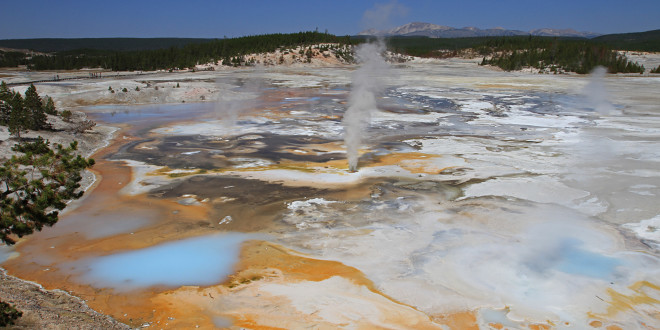Rangers have suspended recovery attempts after a man fell into a hot spring in Norris Geyser Basin at Yellowstone National Park.
We previously reported that Colin Nathaniel Scott, 23, of Portland, Oregon, had fallen in a spring after venturing 225 yards off the boardwalk near Porkchop Geyser. He was visiting Yellowstone with his sister, who reported the incident to rangers. Yellowstone confirmed his death earlier today.
Now, according to the Bozeman Daily Chronicle, after more than a day’s effort to try and retrieve Scott’s body, rangers are throwing in the towel. “They were able to recover a few personal effects,” Park spokeswoman Charissa Reid said, adding, “there were no remains left to recover.”
Norris Geyser Basin, of course, is one of the hottest and most volatile basins in Yellowstone National Park. It also contains some of the most acidic waters. Indeed, Reid said rangers had to quit recovery efforts “due to the extreme nature and futility of it all,” citing dangerous conditions off the boardwalk. From the Chronicle:
“It’s sort of dumb, if I could be so blunt, to walk off the boardwalks not knowing what you’re doing,” said Kenneth Sims, a University of Wyoming geology professor and member of the Yellowstone Volcano Observatory.
“They’re scofflaws essentially, who look around and then head off the boardwalk,” he added.
The basin is a popular attraction in the nation’s first national park, which received a record 4.1 million visitors last year. Water temperatures there can reach 199 degrees, the boiling point for water at the park’s high elevation.
At least 22 people are known to have died from hot spring-related injuries in and around Yellowstone since 1890, park officials said.
Most of the deaths have been accidents, although at least two people had been trying to swim in a hot spring, [according to] park historian Lee Whittlesey, author of the book “Death in Yellowstone.”
Posted signs warn visitors to keep to boardwalks and trails in thermal areas, which feature boiling pools, geysers that can blast hundreds of feet into the air and toxic gases.
The crust that makes up the ground in parts of Yellowstone is formed when minerals underground are dissolved by the high-temperature water, then redeposited on or near the surface.
That crust can be as “thin as a skiff of ice” Reid said.
Norris Geyser Basin is currently open, although portions of the Back Basin are still closed.
 Yellowstone Insider Your Complete Guide to America's First National Park
Yellowstone Insider Your Complete Guide to America's First National Park





